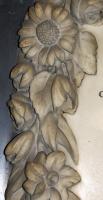
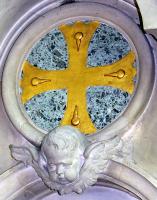
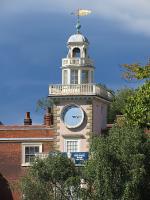
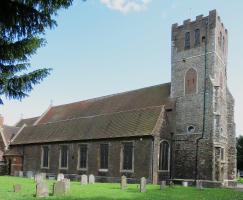
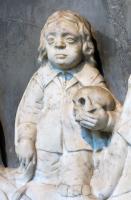
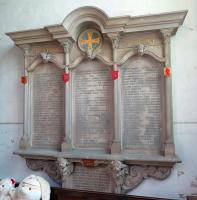

All Hallows Church, Tottenham, stands by Bruce Castle, in the north eastern most part of Middlesex, bordering Essex. It is of ancient origin, with the lower tower dating from the early 14th Century above is 18th Century the nave and chancel and South aisle from the 14th and 15th Centuries and the porch from about 1500, an early 19th Century restoration which saw the rebuilding of the North aisle, and then in 1875, William Butterfield added his bright, bold polychromatic decoration. The monuments we have come to see number something over a score, mostly panels plain and with varying degrees of sculptural ornament, and with a few more grand things.
Tottenham Parish Church of All Saints.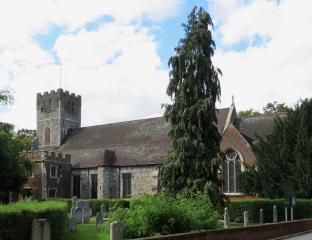
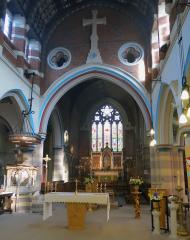
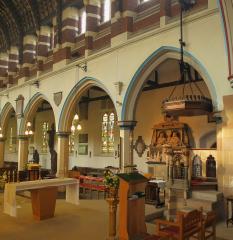
There are three grand monuments of the earlier part of the 17th Century, typical of this period, and we start with those. Firstly Sir John Melton, d.1640, not the earliest of the group, but the most usual.
Sir John Melton, d.1640, and Lady Melton. The monument is raised up high, and exemplifies the kneeler monuments which appeared in late Tudor times and became most popular in the Elizabethan period. This piece shows most of the characteristics we expect. It is centred on the kneeling statues of Sir John Melton and his wife, shown praying, facing each other across a draped faldstool or prayer desk, with a bible on each side. The figures kneel on cushions, typically painted dark red and with corner tassels, as here. A merchant would wear civilian clothes, but as a knight, Sir John Melton wears plate armour above, and we can see his baggy pantaloon-like garment behind. He is bare-headed, with curled hair and a cropped beard, and has a rather smooth face, perhaps through being painted too much. His wife is shown in widow s garb, with black headpiece, and a long shapeless garment which covers her feet, also usual. Often such figures wear ruffs, armour or no, but not here, and both figures are thickset, which is very usual, a sort of plump prosperity.
Sir John Melton, d.1640, and Lady Melton.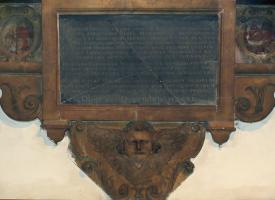
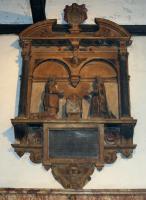
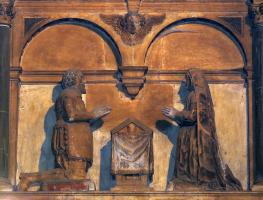
Surrounding our kneeler figures we almost always have an arch, and with a pair, there are often a pair of arches, with the central part either going all the way down behind the prayer desk, or terminating part way, as here. To the sides are tall Corinthian pillars, and this monument is grand enough that they are detached rather than in relief. Above, an entablature (narrow field) and then a shelf and pediment, here curved, and broken in the centre to allow for a cartouche of arms, nicely carved. All this is representative of the period. Below the figures, we have a large central panel with the inscription, in tightly packed lettering, on a black backing, and here in Latin. To each side of this is a cartouche of arms, painted, of the two families, and outside of these are the supporting brackets, curled and with leaf designs carved in relief upon them. Below, a curly apron with scrolling and a central winged cherub head, a larger version of the cherub head in the spandrel between the two arches.
Richard Kandeler, d.1602, his wife Elizabeth (Lock), d.1622/23, as a pair of facing kneelers, and Sir Ferdinando Heyborne, d.1618, and his wife Anne (Candeler). A double monument, with two couples, each under their own archway in a grand alabaster monument. We have the standard pattern: the kneelers facing each other, husband and wife, across their prayer desks, each on their tasselled stool. They are similar in style and pose, and the sculptor, conscious of this, has looked for ways to distinguish them in the minor aspects. Thus the two females have differently styled clothing, with Elizabeth Kandeler wearing a short mantle over her crinkly robe, and with a remarkable up-and-over construction atop her head, and Anne Candeler with more hair showing, and a garment caught at what would have been her waist had she been less stout. But she has at least some indication of figure, and a bust, unlike Elizabeth, whose clothing has little or no indication of a body underneath this is however the more typical arrangement of the time. More about kneeler monuments on this page.
Kandeler (Candeler) double kneeler monument, early 17th Century.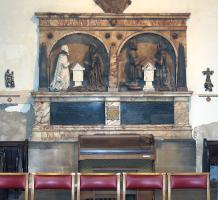
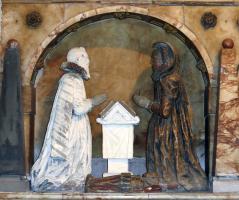
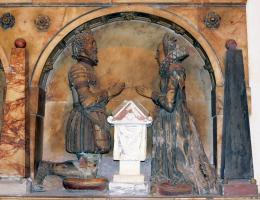
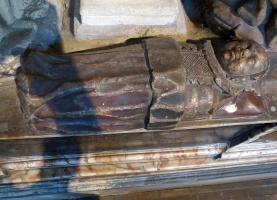
Richard Kandeler s statue has lost most of its paint, with some decay of the alabaster, and so the figure is jarringly pale, but putting this aside, has a good pose, with a sense of chest and thigh under his long robes. He is bare-headed and bearded with a good profile. His feet are covered, less usual in the male figure but de rigeur in the female. Sir Ferdinando Heyborne, as a knight, wears armour rather than a robe, and is stylish and aristocratic. He has the narrowest of ruffs about his neck; the three other figures have fine ruffs in the style of the times. In front of Richard Kandelar and Elizabeth lies their offspring, a recumbent swaddled infant on a small cushion.
For the rest, to the sides of the arches are tall obelisks; black marble at the sides, red-brown alabaster in the centre. There is an entablature above, with a shelf upon it; nothing on top of that because the winged cherub at the base of the John Melton monument rests in the central position. Below the figures, a shelf, and then the central portion of the tomb, with two black panels on alabaster with the inscriptions to the two couples, and between, a small note that Elizabeth Candeler In testymonie of her love erected this monument at her one [own] Charges . The third, basal portion of the tomb is simple stonework. Grand indeed.
Mary (Wilcocks) Barkham, d.1644. Our third early and grand memorial is the most remarkable and charming thing. It is based on a different style of 17th Century monument, with half-figures facing the viewer. But what catches the eye immediately is the lines of children standing below. We do not have another example in the Church, but it is the norm that when a married couple with children are depicted on a 17th Century monument, then those children and there may be many of them are shown beneath the adults, much smaller, ranged boys under the husband, girls under the wife. We see that here, but the youngsters have a charm and pathos remarkable to behold. As the brief inscription says, when their mother died, there were living two boys and seven girls: what we see are 12 children in all, for three other had died: we can see who they were by the skulls tucked under the heads of the two infants, and held by the second-born son. The row of girls is especially excellent in concept: seven girls, successively smaller, each with almost identically grim faces, hair, and poses, each with an arm held by the sister behind, and her own other hand holding the arm of the sister in front; she who is eldest has her free hand, expressively sorrowful, across her breast. The wrapped up infant lies in front of the younger sisters.
Edward Marshall's sculpture of Mary Barkham, Sir Robert Barkham, and their numerous offspring.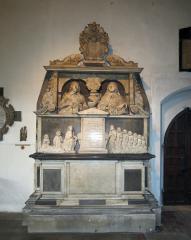
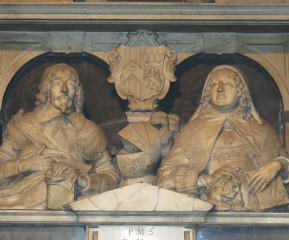
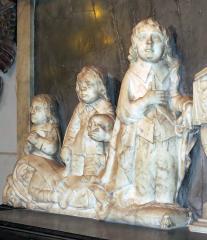
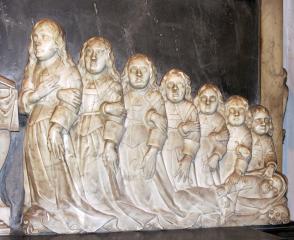
The parents, shown in half figure, are far more expressive and feel a generation later than the well rendered but blander kneeler monuments, though Sir John Melton died but four years before Mary Barkham. They are real portraits: she, with a look of hauteur and pride on her plump face, nose turned slightly upwards, eyes heavily lidded. She wears a short, lacy vestment tied at the throat and open below, revealing a jewelled necklace resting on her formidable d colletage. Her sleeves are full, her cuffs decorated, and bracelets of pearls are looped around the wrists of her expressive hands, one on a book, presumably the Bible, the other on a skull, indicating that when the monument was made, she had deceased while her husband, Sir Robert Barkham, next to her was still alive. He too is proud, aquiline, with ringletted hair, a small moustache, and a tiny pointed beard in Charles I style. He wears plate mail, with a cloak across one shoulder and more drapes below, and also holds a book. Between them rests his plumed helmet, decorated with low relie carvings of flowers. Above that, his shield of arms on a cartouche, this forming the centre of a pair of arches enclosing the figures. To the sides, curly sidepieces, and above, a low swan-necked pediment and central cartouche of arms. As with the Kandeler monument, the whole construction has a sideboard like lower portion, here projecting far forward and resting upon a stone base. On the sides are further coats of arms. The sculptor was Edward Marshall, and what a testimony this monument is to his skill as an artist and designer. More on him on this page.
1820s white-on-black panels: Revd. Roberts, Mary Gwynne, Henry Townsend.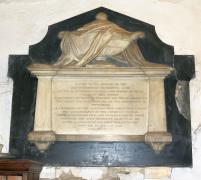
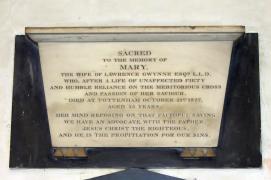
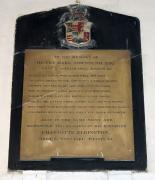
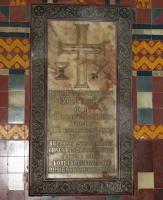 Arts and Crafts panel to Revd. Wilson, d.1898.
Arts and Crafts panel to Revd. Wilson, d.1898.
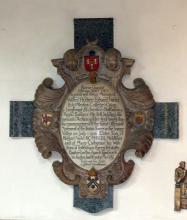 Maurice B. Adams' panel to Lieut. Nield, d.1916.
Maurice B. Adams' panel to Lieut. Nield, d.1916.
Brasses came back in late Victorian times, through till the 1900s, typically with blackletter text and red initials, and inscribed line borders with varying degrees of ornamentation. I saw three such modern brasses in the Church, none of them particularly typical of the period.
One of the Stations of the Cross, Font, Saint from beneath crucifixion, one of the paintings.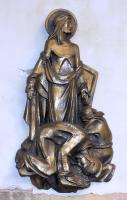



Reredos in All Hallows Church Tottenham.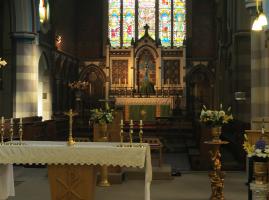
Bruce Castle, adjacent to All Hallows Tottenham and now a museum, belonged to the Bruce family of Robert de Bruce, though this building is of considerably later date than the famous Scotsman, being late 16th Century. Among various interesting things round about, we may note the Tottenham High Cross, 19th Century, replacing a medieval structure. And nearby, a modern sculpture called Embracing Forms, by Vanessa Pomeroy, purchased by the local council in 1983. Decaying white stone, vaguely figural, but more concerned with abstract solid shapes than anything recognisably human.
Bruce Castle Museum, and Tottenham High Cross.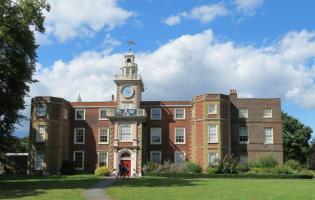
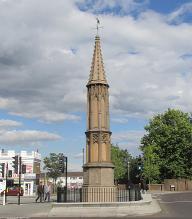
With many thanks to the Church authorities for permission to show pictures of the monuments inside; their website is https://www.achurchnearyou.com/all-hallows-tottenham/.
South to Tottenham War Memorial // and then East to Walthamstow Parish Church // or North to Edmonton Church // West to Tower of Hornsey Church
Monuments in some London Churches // Churches in the City of London
Introduction to church monuments // Angel statues // Cherub sculpture
Visits to this page from 1 Dec 2016: 5,819